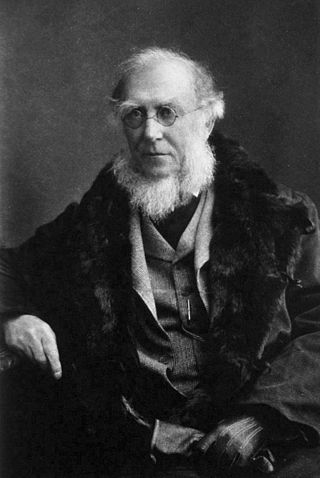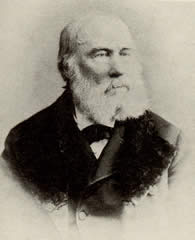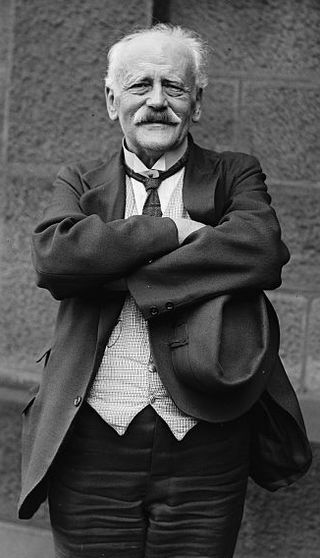Related Research Articles

Sir Joseph Dalton Hooker was a British botanist and explorer in the 19th century. He was a founder of geographical botany and Charles Darwin's closest friend. For 20 years he served as director of the Royal Botanical Gardens, Kew, succeeding his father, William Jackson Hooker, and was awarded the highest honours of British science.

George Bentham was an English botanist, described by the weed botanist Duane Isely as "the premier systematic botanist of the nineteenth century". Born into a distinguished family, he initially studied law, but had a fascination with botany from an early age, which he soon pursued, becoming president of the Linnaean Society in 1861, and a fellow of the Royal Society in 1862. He was the author of a number of important botanical works, particularly flora. He is best known for his taxonomic classification of plants in collaboration with Joseph Dalton Hooker, his Genera Plantarum (1862–1883). He died in London in 1884.

Sir William Jackson Hooker was an English botanist and botanical illustrator, who became the first director of Kew when in 1841 it was recommended to be placed under state ownership as a botanic garden. At Kew he founded the Herbarium and enlarged the gardens and arboretum. The standard author abbreviation Hook. is used to indicate this person as the author when citing a botanical name.

Walter Hood Fitch was a botanical illustrator, born in Glasgow, Scotland, who executed some 10,000 drawings for various publications. His work in colour lithograph, including 2700 illustrations for Curtis's Botanical Magazine, produced up to 200 plates per year.
William Botting Hemsley was an English botanist and 1909 Victoria Medal of Honour recipient.

John Forbes Royle, British botanist and teacher of materia medica, was born in Kanpur in 1798. He was in charge of the botanical garden at Saharanpur and played a role in the development of economic botany in India.

The Botanical Magazine; or Flower-Garden Displayed, is an illustrated publication which began in 1787. The longest running botanical magazine, it is widely referred to by the subsequent name Curtis's Botanical Magazine.

Robert Wight MD FRS FLS was a Scottish surgeon in the East India Company, whose professional career was spent entirely in southern India, where his greatest achievements were in botany – as an economic botanist and leading taxonomist in south India. He contributed to the introduction of American cotton. As a taxonomist he described 110 new genera and 1267 new species of flowering plants. He employed Indian botanical artists to illustrate many plants collected by himself and Indian collectors he trained. Some of these illustrations were published by William Hooker in Britain, but from 1838 he published a series of illustrated works in Madras including the uncoloured, six-volume Icones Plantarum Indiae Orientalis (1838–53) and two hand-coloured, two-volume works, the Illustrations of Indian Botany (1838–50) and Spicilegium Neilgherrense (1845–51). By the time he retired from India in 1853 he had published 2464 illustrations of Indian plants. The standard author abbreviation Wight is used to indicate this person as the author when citing a botanical name.

Augustine Henry was a British-born Irish plantsman and sinologist. He is best known for sending over 15,000 dry specimens and seeds and 500 plant samples to Kew Gardens in the United Kingdom. By 1930, he was a recognised authority and was honoured with society membership in Belgium, Czechoslovakia, Finland, France, and Poland. In 1929 the Botanical Institute of Peking dedicated to him the second volume of Icones plantarum Sinicarum, a collection of plant drawings. In 1935, John William Besant was to write: 'The wealth of beautiful trees and flowering shrubs which adorn gardens in all temperate parts of the world today is due in a great measure to the pioneer work of the late Professor Henry'.

Otto Stapf FRS was an Austrian born botanist and taxonomist, the son of Joseph Stapf, who worked in the Hallstatt salt-mines. He grew up in Hallstatt and later published about the archaeological plant remains from the Late Bronze- and Iron Age mines that had been uncovered by his father.

Emil Bretschneider was a sinologist of Baltic German ethnicity and a correspondent member of the Académie française. He operated in the Russian Empire. He graduated from the medical school of University of Dorpat in Dorpat Estonia, and was first posted as a physician by the Russian legation to Tehran (1862–65). From 1866 to 1883 he was posted as physician by the Russian legation to Pekin.

William Ramsay McNab was a Scottish physician and botanist.

Matilda Smith (1854–1926) was a botanical artist whose work appeared in Curtis's Botanical Magazine for over forty years. She became the first artist to depict New Zealand's flora in depth, the first official artist of the Royal Botanic Gardens at Kew, and the second woman to become an associate of the Linnaean Society. The standard author abbreviation M.Sm. is used to indicate this person as the author when citing a botanical name.
Faberia is a genus of Chinese flowering plants in the family Asteraceae.
Joseph Whittaker was a British botanist who visited South Australia in 1839. Whittaker has 300 plants from that trip in Kew Gardens and a large collection of pressed British plants in Derby Museum and Art Gallery.

Quercus franchetii, commonly known as the zhui lian li evergreen oak, is a species of oak in the Ilex section of the genus, native to a wide area of eastern Asia. It is an oak native to China, northern Thailand and Vietnam, growing at altitudes between 800 and 2,600 metres.
Stephen Troyte Dunn was a British botanist. He described and systematized a significant number of plants around the world, his input most noticeable in the taxonomy of the flora of China. Among the plants he first scientifically described was Bauhinia blakeana, now the national flower of Hong Kong.
Mazus gracilis is a plant species native to the Provinces of Henan, Hubei, Jiangsu, Jiangxi and Zhejiang in China. It grows on lake shores, river banks, and other moist areas at elevations below 800 m.
Allium prattii is an Asian species of wild onion native to Assam, Nepal, Sikkim, Bhutan, and China. It is found at elevations of 2000–4900 m.
Quercus augustinii is a rare species of tree in the beech family Fagaceae. It has been found in Vietnam as well as Guangxi, Guizhou, and Yunnan Provinces in southern China. It is placed in subgenus Cerris, section Cyclobalanopsis.
References
- 1 2 3 4 5 "Forbes Family Papers" . Massachusetts Historical Society website.
- ↑ Reitwiesner, William Addams. "The Ancestors of Senator John Forbes Kerry (b. 1943)". Wargs.com, accessed 8-20-2015.
- 1 2 3 4 5 6 "Obituary Notices". Proceedings of the Linnean Society of London, 1909, pp. 38–39.
- 1 2 3 4 5 Thiselton-Dyer, William Turner. "Historical Note". Journal of the Linnean Society, vol. 36, 1903–05, p. v.
- 1 2 "Forbes, Francis Blackwell (1839-1908)". JSTOR Global Plants website.
- ↑ Britten, James, ed. Journal of Botany, British and Foreign, vol. 43. London: West, Newman, 1905, p. 323.
- ↑ International Plant Names Index. F.B.Forbes.